Hearst Castle is a National Historic Landmark located on California's Central Coast. Built between 1919 and 1947 by William Randolph Hearst, it features 127 acres of gardens, terraces, pools, and walkways, as well as a main mansion with Spanish and Italian antiques. A private movie theater, zoo, tennis courts, and swimming pools were also part of the estate's opulent amenities.


The All-Important Wristband of Destiny
Subject Rating: 7/10
Captured from a high angle, this image zeroes in on the crucial accessory of modern-day adventure: the wristband. Proudly encircling a tanned arm, this light blue band displays vital information: "ps1z4", "1512299", and the date "08/19/1_". Just below, the feet of the wristband's wearer are visible in sensible grey and pink sneakers, anchored to a ground composed of speckled concrete and small pebbles. Further back, another pair of legs in dark leggings and a hand clutching a pamphlet titled "HEARST CASTLE BUILDING THE DREAM" confirms their destination, adding context to the significance of the wristband – it's the golden ticket to opulent history! Partial glimpses of other people in the background add to the bustling, event-day atmosphere.
From a photographer's standpoint, the composition uses a top-down perspective to make the wristband the undeniable star. The selective focus is spot on, rendering the text on the band tack-sharp while the background melts away into a pleasant blur, isolating the key subject. The natural lighting, while a bit contrasty, adds realism and texture to the skin and the ground. It effectively documents a moment of readiness, perhaps waiting in line or just entering the premises. While the subject matter is simple (an arm and a wristband), the inclusion of the Hearst Castle pamphlet elevates it from just a random object to a narrative element, hinting at the grander experience awaiting them. It's a fun, relatable shot that captures the mundane yet essential first step of many excursions.
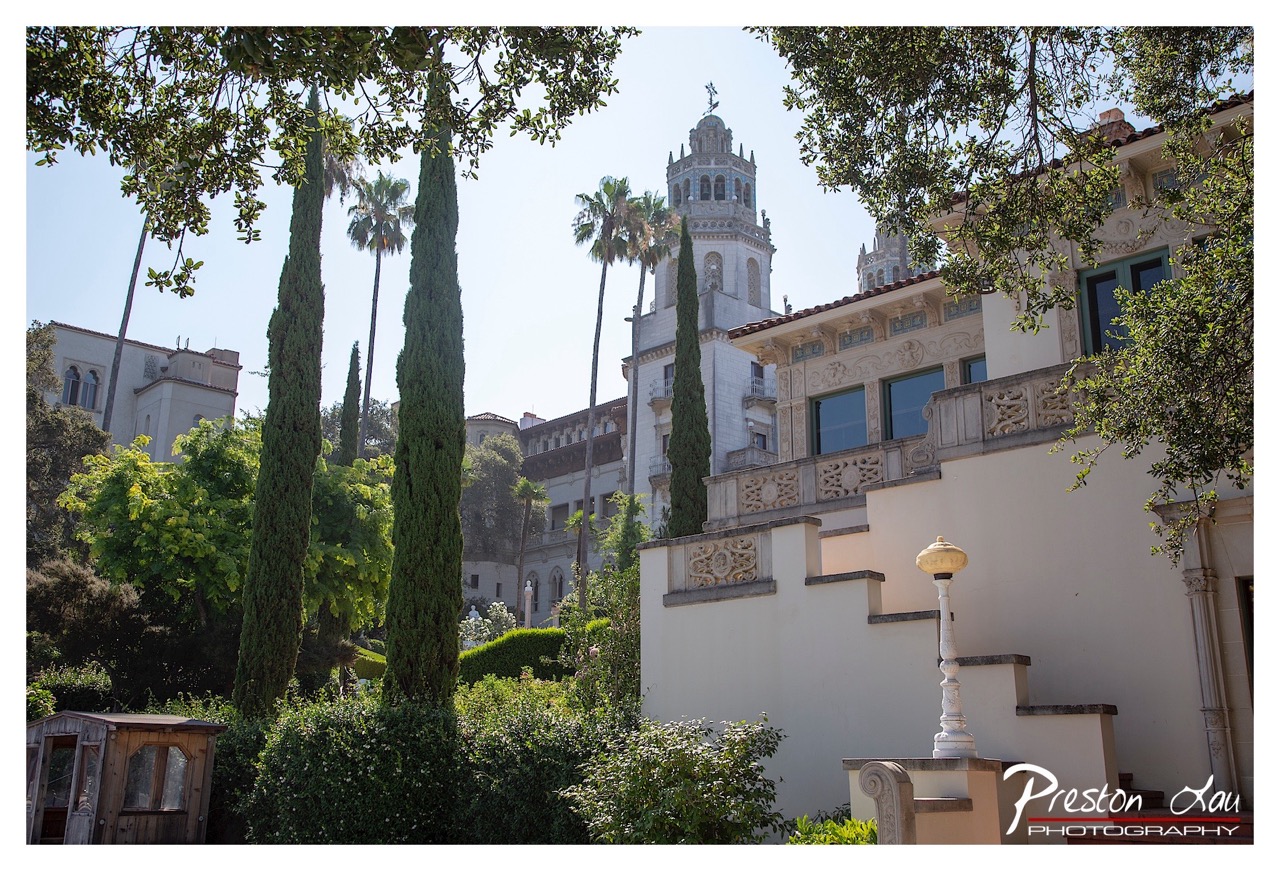

Hearst Castle Hide and Seek
Rating: 7/10
Ah, Hearst Castle, peeking through the trees like a grand dame trying to play coy. The main subject here, the magnificent architecture of the castle itself, rates a solid 8/10 for sheer impressive scale and intricate detail, even partially obscured. What's happening is a classic architectural shot, framed by nature, capturing a sunny day at a rather famous estate. The mood is stately and a bit exclusive, like catching a glimpse of old money lounging in their sprawling garden. You can almost hear the faint echo of lavish parties and maybe a silent film star or two strolling the grounds. The foreground features some dramatically tall cypress trees acting as natural vertical lines, attempting to add a touch of formal garden elegance, while some scrubby bushes and a rather charmingly old-fashioned lamp post occupy the lower steps.
From a photography perspective, the composition uses the trees effectively to frame the shot, drawing the eye towards the central tower, which is a nice touch. The steps in the foreground also create a diagonal leading line, albeit a bit truncated by the crop. However, the lighting is typical of a bright, sunny day, which gives definition but also creates potentially harsh shadows and bright highlights, especially on the white walls and steps – maybe a diffuser or different time of day was in order to soften that contrast? The colors are pleasant, with the green foliage contrasting nicely with the light-colored architecture and the blue sky, though nothing particularly pops. The watermark is prominently placed, which is a common practice, reminding us who's behind the lens, Preston Lau Photography, presumably capturing this slice of Californian opulence before dashing off for a quick dip in the Neptune Pool (one can dream!). Overall, it's a competent shot that captures the essence of the location, though perhaps a little less sun could have made the details sing even more.
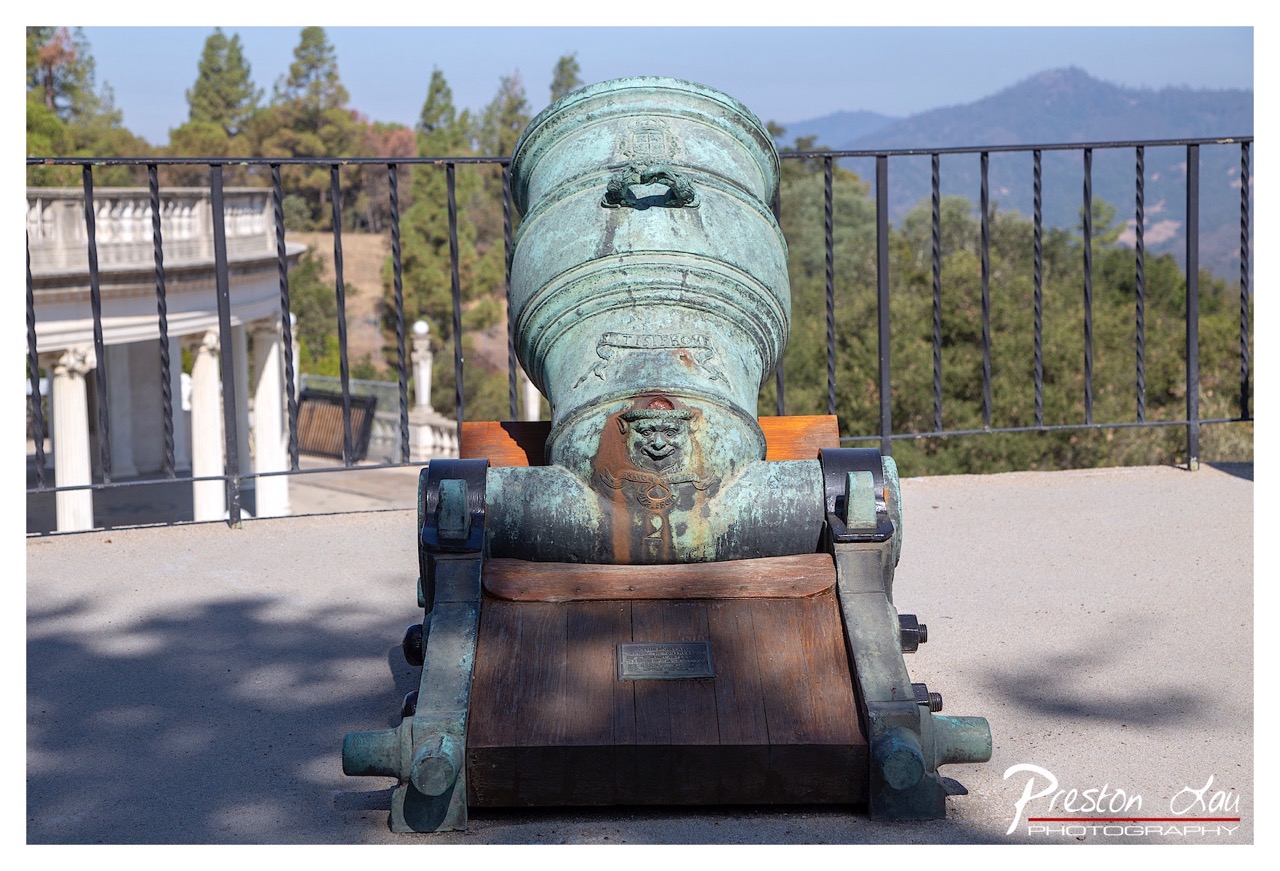
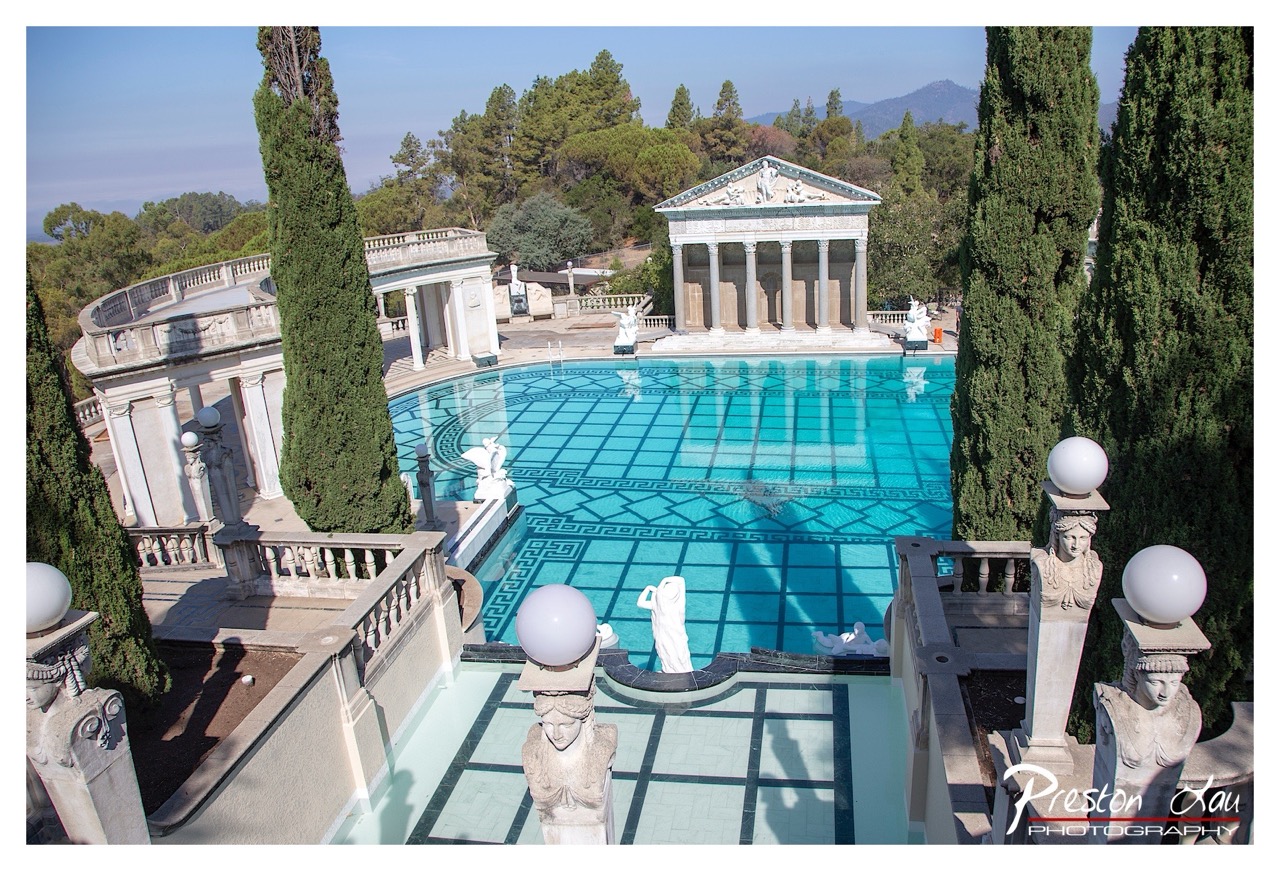

Neptune's Bling Pool
Subject Rating: 9/10
Ah, the Neptune Pool at Hearst Castle, a subject so grand it practically takes the photo of itself – though credit is due to Preston Lau, whose watermark confirms he *was* there. We're looking down at this ridiculously opulent swimming pool, which looks less like a place for a quick dip and more like a set piece from a Roman emperor's fever dream. The water is a stunning, almost unbelievable shade of blue, reflecting the geometric patterns of the pool's bottom and the slightly wavy grid of shadows from above. Flanking the pool are classical-style buildings with columns and statues, including a large temple-like structure at the far end that looks ready to host a toga party. The mood is definitely one of extravagant luxury and timelessness, feeling more like ancient Rome than 20th-century California, albeit with slightly better plumbing. Towering cypress trees act as natural pillars framing the scene on the left and right, adding vertical interest and a sense of scale to the horizontal sprawl of the pool complex. In the foreground, we see ornate balustrades and bust statues topped with glowing globes, adding to the theatrical, over-the-top aesthetic. The background is a lush green hillside leading to hazy distant mountains under a clear blue sky, grounding the architectural fantasy in a real landscape.
From a photographic standpoint, the composition uses a high vantage point, offering a comprehensive view of the pool and its surroundings. The leading lines of the pool's edge and the lower architectural elements guide the eye towards the central expanse of water and the temple beyond. The lighting, likely from the midday sun, is bright and contrasty, highlighting the details of the architecture but also creating some strong shadows, particularly visible on the steps and the lower pool level. The vibrant blues and greens pop against the neutral stone colors, making the pool the undeniable star of the show. While the bright light captures the sparkle on the water and the detail on the buildings, shooting earlier or later in the day might have offered softer light and longer shadows, adding a different kind of drama or depth. Still, this shot successfully captures the sheer scale and theatrical beauty of this iconic California landmark, making you wonder just how many golden inflatable swans one could fit in that pool.
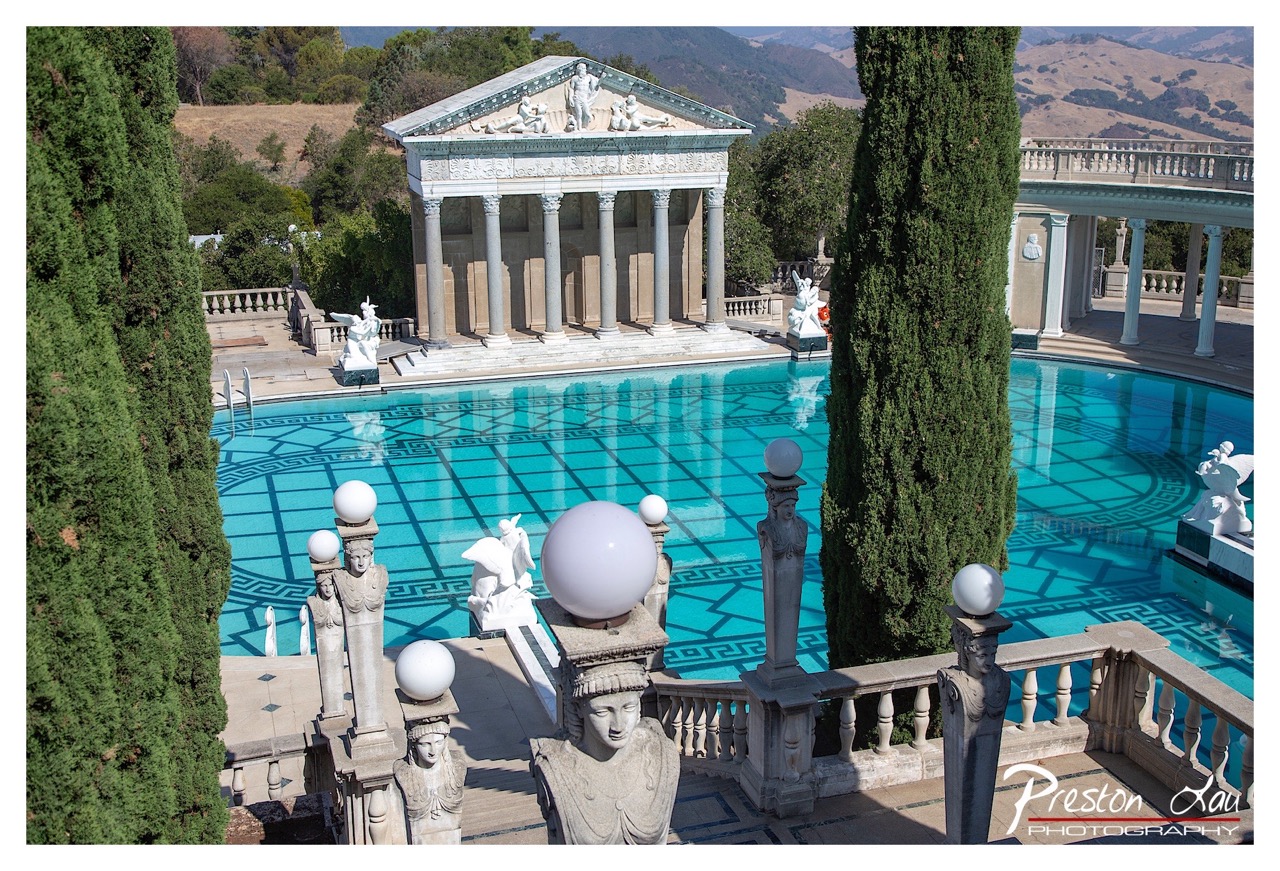

Roman Splendor by the Pool
Rating: 9/10
Ah, the Roman Pool at Hearst Castle – a magnificent homage to antiquity, complete with a temple facade that looks ready to host a toga party, rating a solid 9/10 for sheer opulent spectacle. This image captures the breathtaking grandeur of the pool itself, its vibrant blue tiles forming a geometric labyrinth beneath the inviting water, reflecting the clear California sky. White marble statues of gods and goddesses stand guard, adding a touch of classical drama, while massive cypress trees flank the scene like silent sentinels. The mood is undeniably lavish and serene, transporting you to a sun-drenched fantasy world where even the swimming pool has a backstory longer than most novels.
From a photographic perspective, the high-angle composition provides an excellent overview of the pool's intricate design and the surrounding architecture, using the foreground steps and railing as natural leading lines into the watery depths. The bright, sunny lighting enhances the vivid blue of the water and creates striking contrasts, though the harsh midday sun can sometimes be a photographer's nemesis, making sure those highlights don't blow out is key! The lush green trees frame the sides, adding depth, although the prominent one on the left does slightly crowd the edge – perhaps just asserting its ancient presence. The overall style leans towards grand architectural documentation, aiming to showcase the sheer scale and detail of this man-made wonder, though the prominent watermark reminds us that someone else got to dip their toes in, photographically speaking. It's almost enough to make you wish you'd packed your speedo and a scroll of ancient jokes.
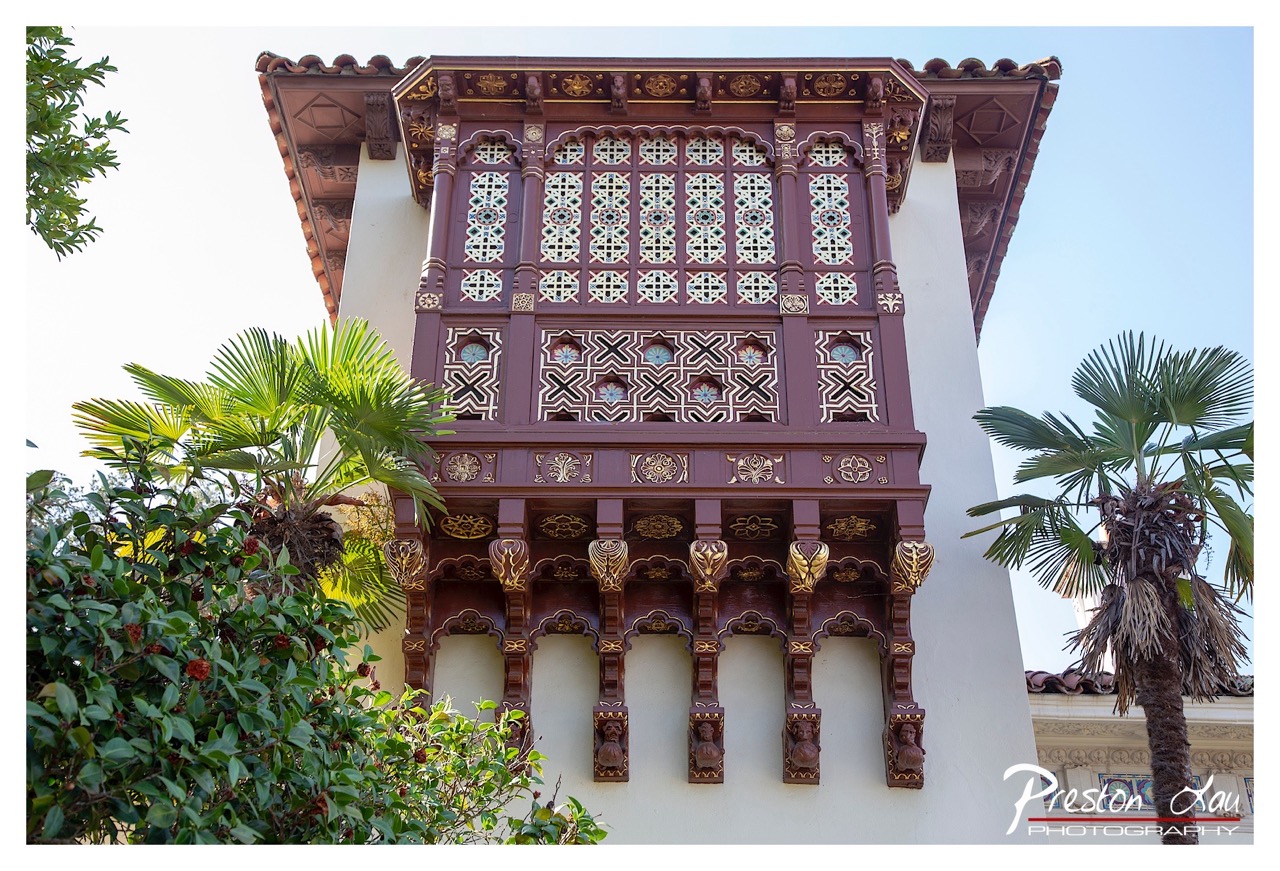

The Balcony That Refused to Be Boring
Rating: 8/10
Well, hello there, little piece of architectural exuberance! Our subject here is an absolutely bonkers, over-the-top ornate balcony or bay window, which scores a solid 8/10 for its sheer dedication to detail. This isn't just a balcony; it's a whole wooden treatise on geometry, flora, and whatever those carved faces are supposed to be – possibly grumpy garden gnomes who took woodworking classes. Adorned in a rich, deep red with liberal dollops of gold trim, it screams "Look at me!" in multiple languages. The intricate geometric patterns and delicate floral carvings are mesmerizing, making you wonder if the carpenter had a serious caffeine habit or just *really* loved their job. The mood is decidedly opulent and a touch theatrical, nestled under a bright sky with lush green sentinels (palm trees and a bushy friend) standing guard.
From a photography perspective, this shot does a decent job of capturing the main event. The composition puts the ornate structure front and center, allowing the eye to wander over the endless details. The framing by the greenery on either side adds a natural, organic contrast to the rigid geometry, though the left palm is perhaps a touch distracting just clipping the frame. Lighting is bright and highlights the gold accents beautifully, though the sky is leaning a bit towards the "bleached out" aesthetic – a classic bright sky challenge. The colors are vibrant, perhaps a little boosted, but it helps to emphasize the richness of the woodwork. Overall, it's a clear, descriptive shot that showcases an incredible piece of craftsmanship, even if the dynamic range could have been a tad better managed to keep the sky from looking quite so... enthusiastic. A solid capture for an architectural marvel.
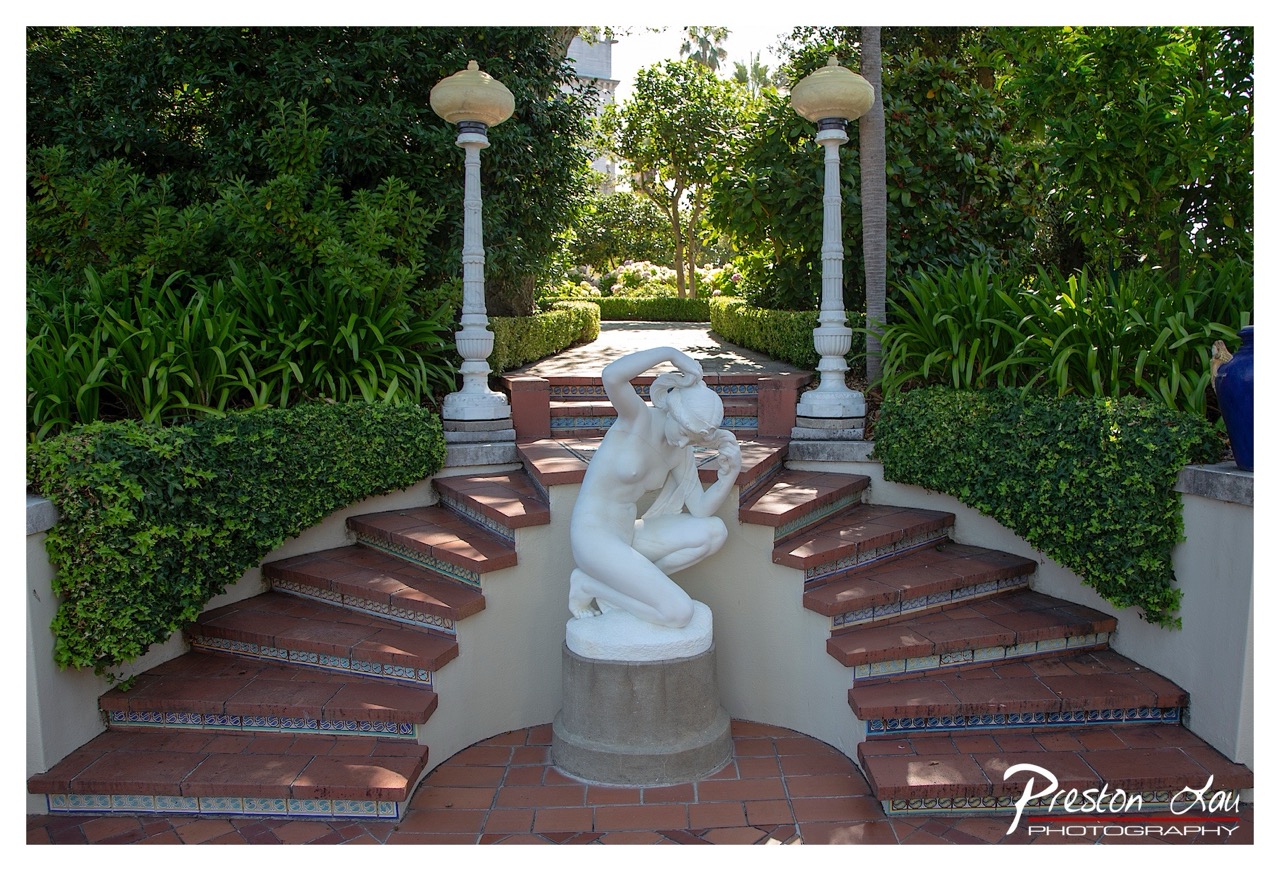

The Kneeling Muse and the Symmetrical Steps
Subject Matter: 7/10
Behold, a garden scene so perfectly balanced, you could set your watch by it! Front and center, we have a rather contemplative statue of a kneeling figure, possibly pondering the meaning of mulch or just wondering if anyone remembered to water the begonias. Flanking this pensive piece of art are two majestic, if slightly ornate, lampposts and a pair of sweeping, brick staircases. The steps are a nice touch with their decorative tile risers, adding a splash of subtle color to the earthy tones. The composition here is the epitome of formal symmetry, drawing the eye directly to the central statue and offering a clear, albeit predictable, path through the scene.
Beyond the architectural flair of the foreground, the background unfolds into a lush, green oasis. Carefully trimmed hedges line a pathway that recedes into the distance, hinting at more garden delights beyond. The foliage is thick and vibrant, creating a wonderful contrast with the white stone elements. The lighting is soft and diffused, lending a tranquil mood to the entire picture and flattering the statue nicely without harsh shadows. It’s a classic, serene garden tableau – well-executed and aesthetically pleasing, if not exactly breaking any photographic boundaries. It's the kind of image that makes you want to sit on those steps and just... be tranquil. Or maybe just appreciate how much effort goes into trimming hedges that perfectly.
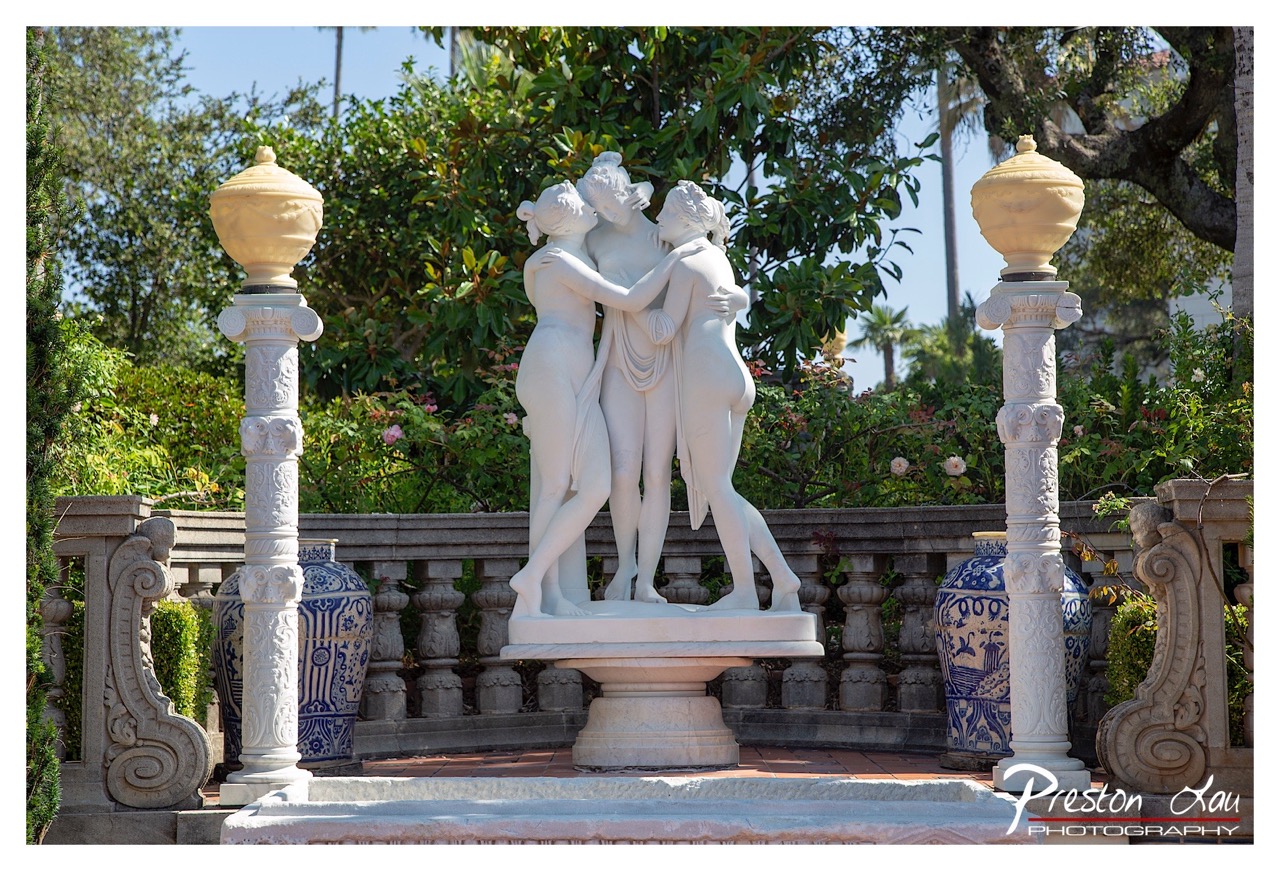

The Three Graces in a Sunny Garden - 8/10
This image captures a classical white marble sculpture depicting The Three Graces in a lush, sun-drenched garden setting. The three figures are shown embracing each other, symbolizing beauty, charm, and joy, standing atop a multi-tiered circular base which appears to be part of a fountain structure. Flanking the sculpture are two ornate, white marble pillars topped with large, pale yellow urns that presumably serve as lighting fixtures. Behind these elements, a stone balustrade runs horizontally across the frame, adding a sense of structure and formality to the garden. The mood is serene and classical, evoking a feeling of timeless elegance amidst vibrant natural beauty. Large blue and white ceramic pots are visible between the pillars and the balustrade, adding a pop of color and pattern to the scene.
From a photographic perspective, the composition is quite symmetrical, centering the main sculpture and using the pillars as effective framing devices. The bright midday sun provides strong, direct lighting, highlighting the white marble and creating distinct shadows, which gives the scene a crisp, high-contrast look. While this lighting can be challenging, the exposure seems well-handled, avoiding blown-out highlights on the bright white surfaces for the most part. The colors are rich, with the deep greens of the trees and shrubs providing a strong backdrop to the white and pale yellow architectural elements. The blue and white pots add a touch of unexpected vibrancy, like someone couldn't resist a good bargain on oversized ceramics. The watermark adds a personal touch, ensuring everyone knows who captured this moment of classical embraces and potentially questionable pot choices.
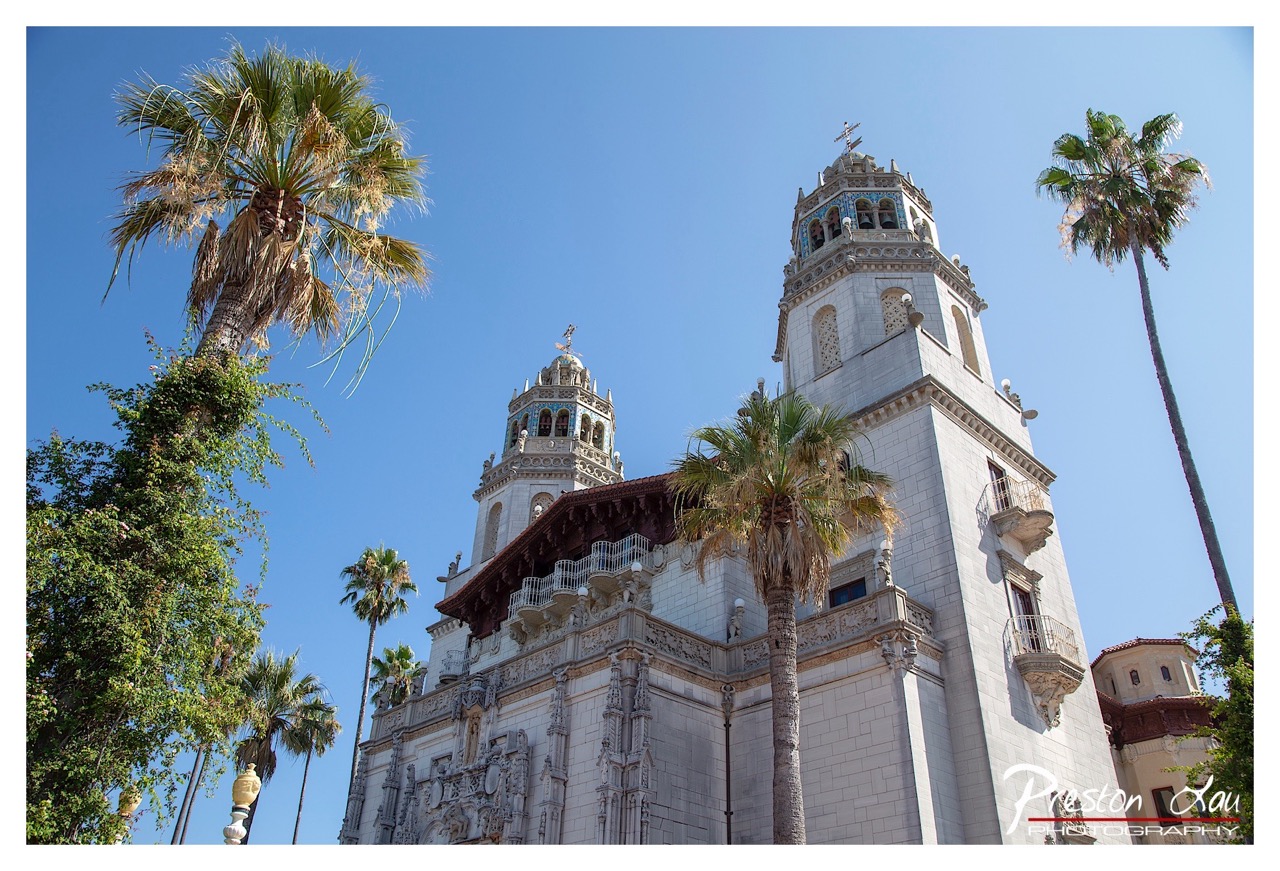

Hearst Castle Grandeur
Subject Rating: 9/10
This shot takes us on a sun-drenched trip up the California coast, gazing upwards at the impressive towers of Hearst Castle. The subject matter itself is iconic, deserving a high rating for its historical and architectural significance, a genuine "wow" kind of place. What's 'happening' is simply a glorious day presenting this extravagant structure in all its glory, framed by equally impressive, if somewhat unruly, palm trees. The mood is grand and aspirational, capturing the opulent vision of William Randolph Hearst under a spectacularly clear blue sky. It feels like stepping back in time to an era of immense wealth and architectural ambition, combined with the laid-back, sunny vibe of the Californian coast.
From a photographic perspective, the low angle certainly emphasizes the sheer scale and height of the main tower, making it loom majestically against the sky. It's a classic technique for conveying grandeur, although it does mean sacrificing a clear view of the base (or sanity when getting the shot!). The composition with the palm trees is a bit of a mixed bag – the leaning palm on the left adds some foreground interest and a tropical touch, almost looking like it's trying to hug the castle, while the tall, skinny one on the right acts as a vertical counterpoint but feels a little squeezed in. Lighting is typical midday sun: bright, punchy, creating strong contrast and vibrant colors, particularly the brilliant blue sky and the bright stone of the castle. While great for showcasing the structure, it can be a bit harsh, flattening some detail in the shadows. The ornate details on the facade and the colorful mosaics on the tower tops add visual complexity and are well-rendered despite the strong light. It’s a solid capture of a challenging subject under typical sunny conditions, perhaps benefiting from a slightly different angle or time of day to soften the light and improve the tree framing, but undeniably capturing the essence of the place.
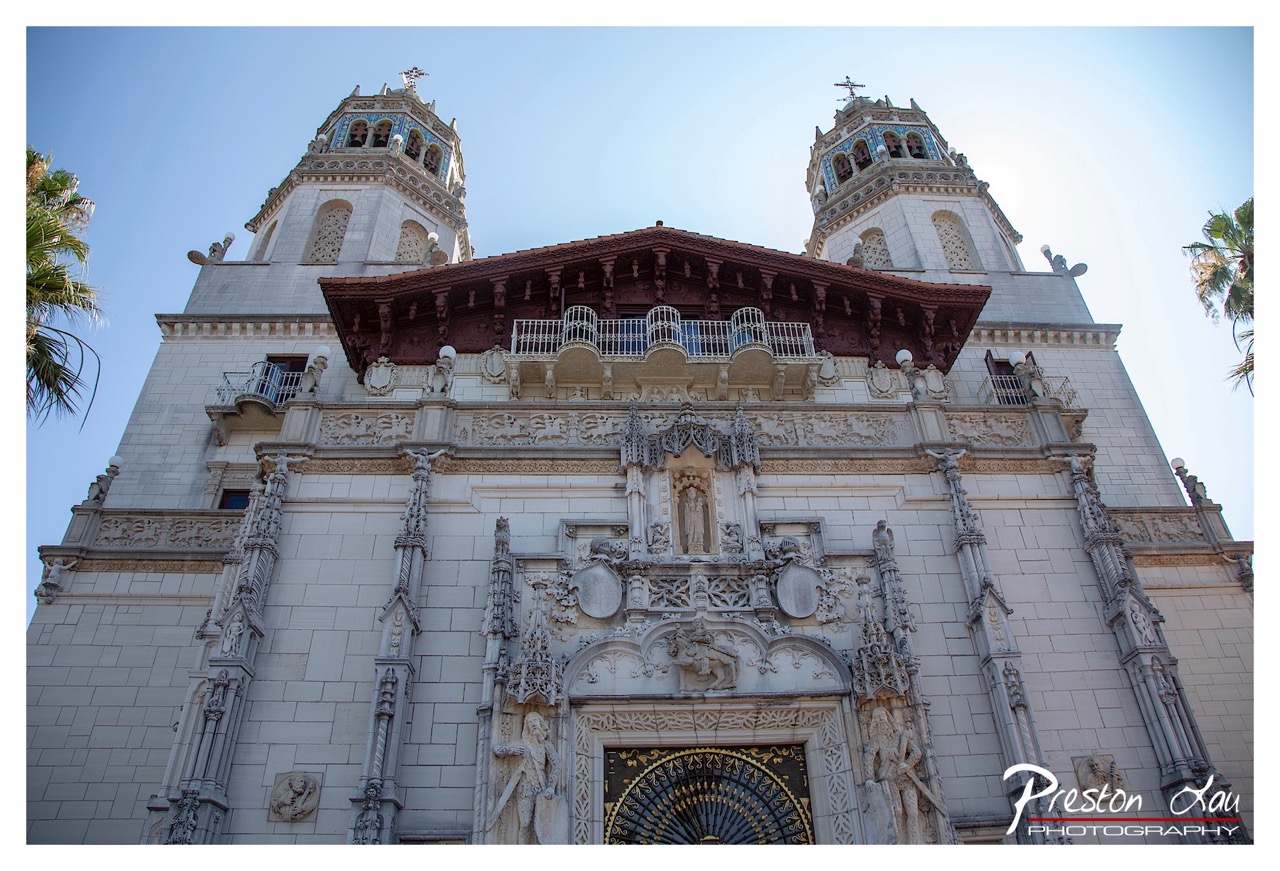

Hearst Castle Grandeur
Rating: 6/10
Well, hello there, architectural show-off! This shot of what looks suspiciously like Hearst Castle decides to embrace the low-angle look, making the building feel even more colossal, as if it wasn't already trying to touch the heavens with those twin towers. The sheer scale of the structure is undeniable, and the camera does a decent job of capturing the 'more is more' aesthetic with all its intricate carvings, statues (Are those tiny people or just really detailed decor? Hard to say!), and ornate balconies. The clear blue sky provides a clean background, letting the white facade pop, while the reddish roof adds a touch of warmth to the stone symphony. It certainly conveys a sense of awe and historical weight, despite the slightly comedic effect of looking straight up its... facade.
From a technical standpoint, the bright midday sun is giving us some classic high-contrast drama – we've got deep shadows playing hide-and-seek with blown-out highlights, especially near the top left sky. While it accentuates some textures, it flattens others and makes you wish you'd brought a tripod and come back at golden hour (or maybe just cloudy hour). The composition is largely symmetrical, drawing the eye up the center, though the palm trees on the edges add a little natural frame, awkwardly cropped on the left. The detail capture is pretty good for the most part, letting us appreciate the insane amount of work that went into every corner, balcony railing, and door knocker. It's a solid record of the place, though the lighting makes it lean more towards a documentary shot than a moody masterpiece. And yes, the watermark confirms the photographer's claim to this architectural eye-poke.
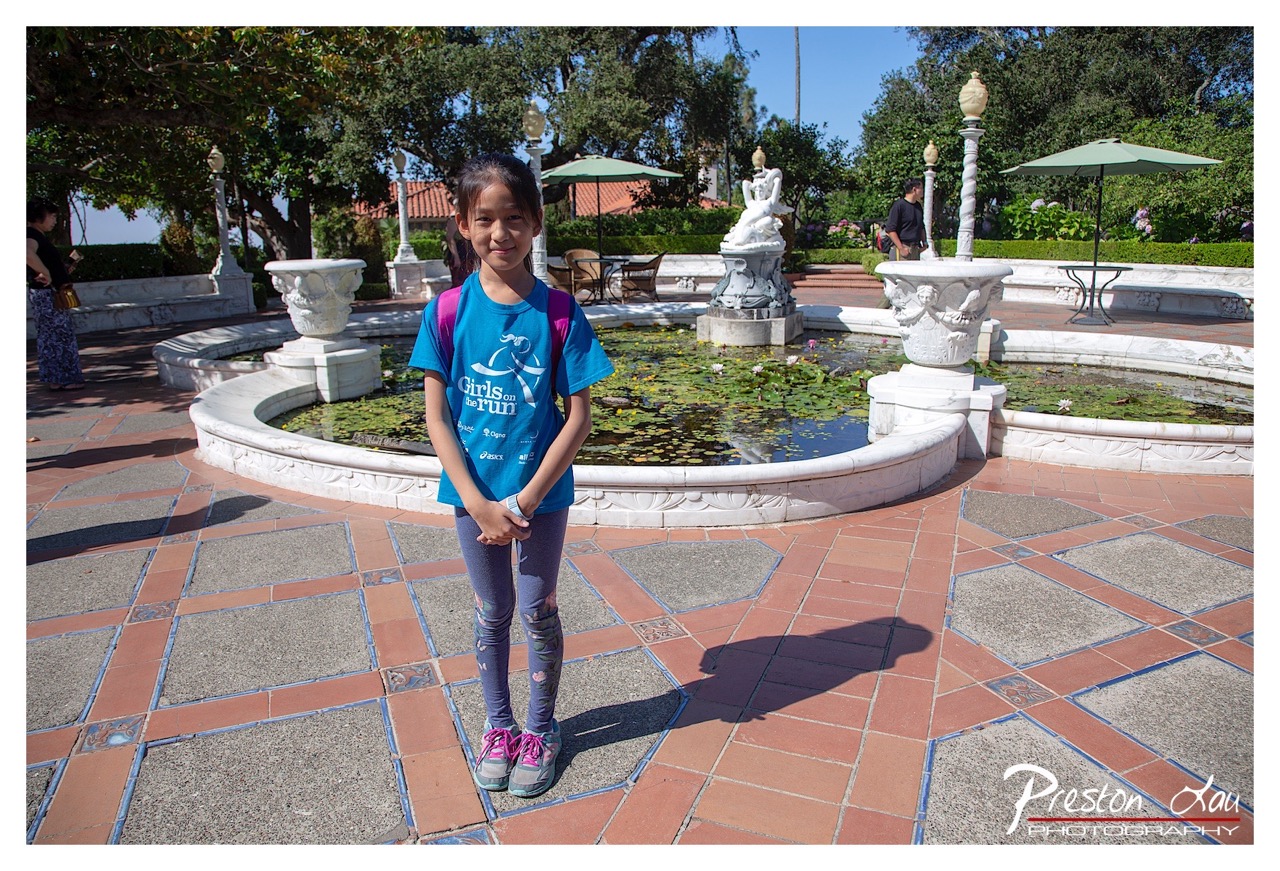

Girls on the Run at the Fountain of Eternal Sunshine (and Harsh Shadows)
Rating: Subject 7/10
Our subject, a bright-eyed young lady in a fetching blue "Girls on the Run" tee and purple leggings, stands front and center, practically declaring, "Here I am!" in front of a rather grand fountain scene. She's paused mid-adventure, hands clasped politely, giving the camera a sweet smile. The mood is definitely sunny and perhaps a bit formal, like a classic vacation photo stop. Her pink backpack adds a pop of color and hints at a day of exploration, while the floral pattern on her leggings adds a touch of whimsy. The pertinent objects here are definitely the girl, the imposing marble fountain complete with statues (is that a reclining nymph?), and the wonderfully intricate, if slightly distracting, patterned pavement beneath her feet. It's a classic stance, perfectly framed in the middle, which is great for clearly showing the subject, though perhaps not the most dynamic photographic composition.
From a photography standpoint, this shot is a masterclass in battling midday sun – and the sun definitely won this round. The lighting is direct and harsh, creating deep shadows, particularly the large, distinct shadow of the girl stretching out on the ground behind her, which adds an unwanted graphic element. It also makes the beautiful fountain and background a high-contrast challenge. Color-wise, the blues and greens are vibrant thanks to the bright light, but the harshness flattens the scene somewhat. The background is a lovely tiered garden with trees, umbrellas offering respite from the glare, and hints of other people enjoying the setting. While the subject matter is charming and the location beautiful, the composition is straightforward, and the lighting presents a significant technical hurdle, resulting in a snapshot feel despite the potential for a more polished portrait.
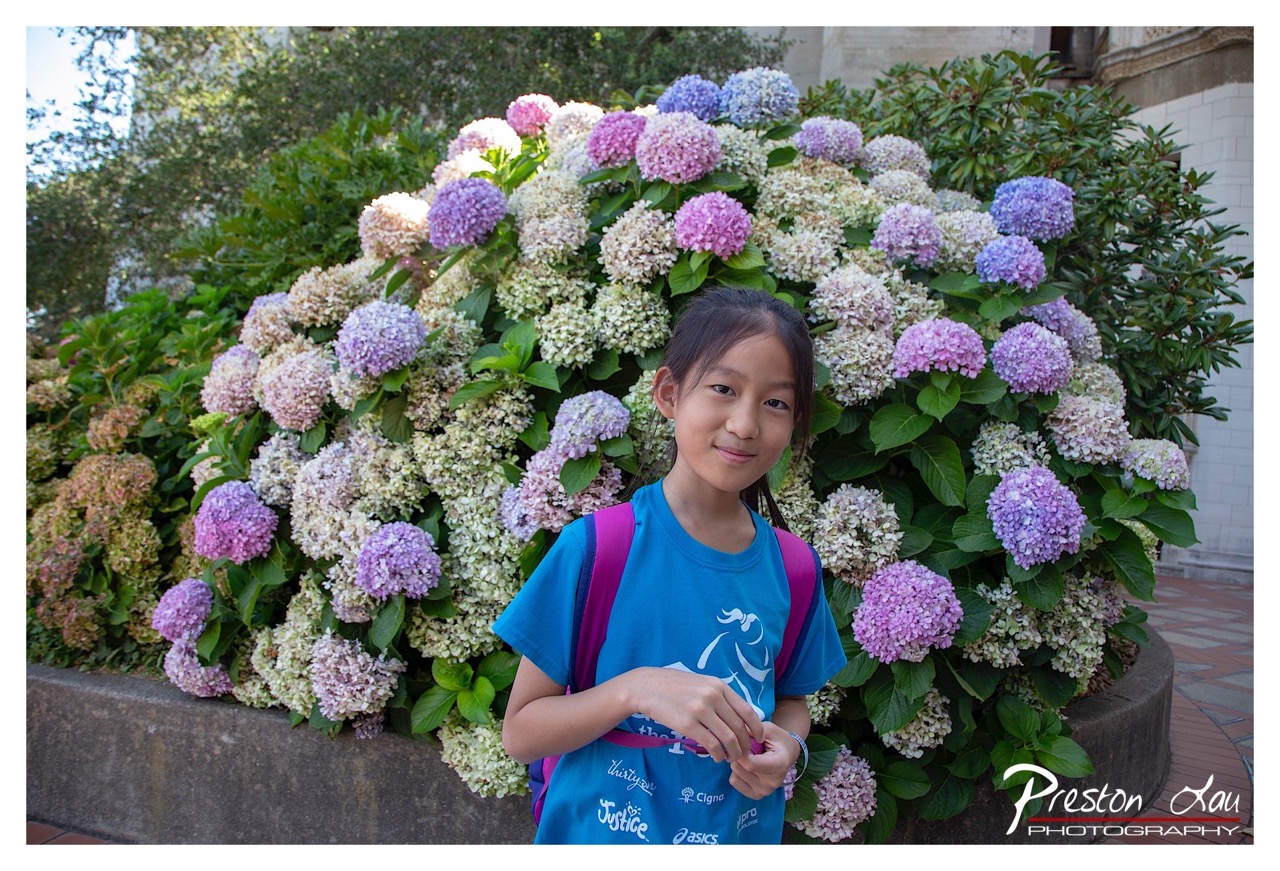

Title: Hydrangea Guardian and Her Floral Fortress
Rating: Subject Rating: 8/10
In this vibrant scene, a young girl, sporting a bright blue tee and a pink backpack, offers a shy smile to the camera, looking like she's just stumbled upon a floral wonderland – or perhaps she's the official guardian of this colossal hydrangea bush. The mood is undeniably cheerful and summery, radiating the simple joy of a sunny day amidst nature's bounty. The background is dominated by an absolutely massive hedge overflowing with hydrangeas in various shades of purple, pink, and white, backed by lush green foliage and a hint of architectural structure peeking through the leaves on the right. The sheer scale of the blossoms makes the subject feel like a small but important detail in a much larger, blooming narrative.
The composition places our small subject slightly off-center but firmly framed by the overwhelming presence of the flowers, making her look like she's part of the botanical landscape rather than just posing in front of it – talk about being overshadowed! Lighting appears soft and even, likely diffused daylight, doing justice to both the girl's expression and the delicate colors of the blossoms, though the deep shadows lower right suggest the sun might be nearby, lurking with intent to create harsh light. The color palette is a delightful contrast between the cool blues and purples, warm pinks, and fresh greens, making the image pop. Style-wise, it's a classic environmental portrait, placing the subject in context, but one could argue the sheer scale of the flowers almost turns the girl into a secondary object – maybe the hydrangeas are the *real* subject here, and she's just added for scale? Preston Lau Photography certainly captured the impressive scale, just try not to let the subject get completely swallowed by the botanical beast next time, unless it's a commentary on humanity's place in the face of overwhelming natural beauty (or simply a really enthusiastic gardener). The grey stone wall/planter box adds a necessary visual anchor at the bottom, preventing the whole scene from floating away on a wave of petals.
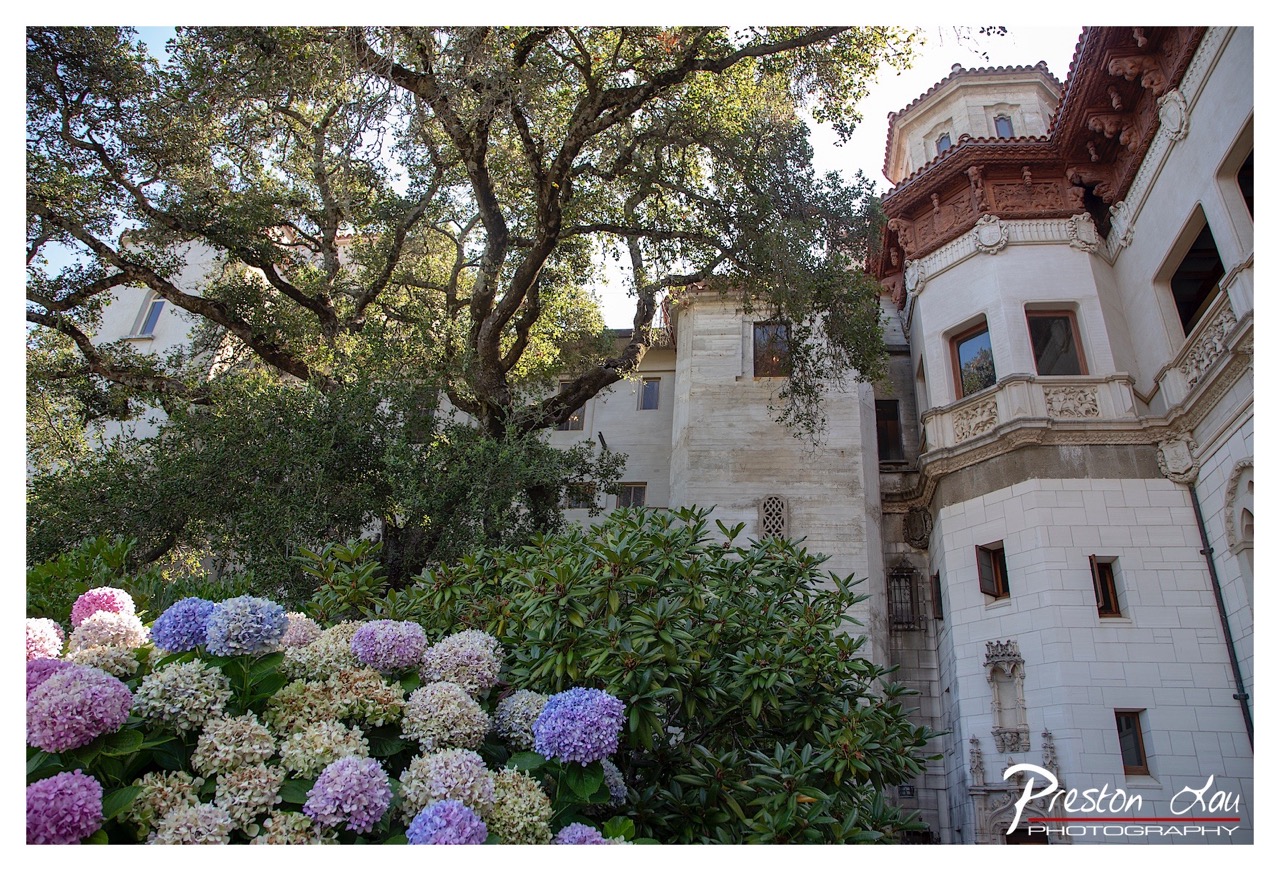

The Verdant Gatekeeper
Subject Rating: 8/10
Behold, the battle of the titans: Nature vs. Architecture, starring a gargantuan tree, a fancy building, and a chorus line of show-off hydrangeas! In this stately scene, a majestic, ancient tree throws its impressive branches across the sky, acting as a furry, leafy bouncer guarding the entrance to a grand, multi-story building. Below, a vibrant explosion of hydrangeas in shades of purple, pink, and blue puts on a delightful foreground display, adding a splash of color to the rather more stoic stone facade behind them. The mood is one of opulent nature coexisting with human grandeur, albeit with nature currently winning the space race for prime photographic real estate. The building itself, likely a historical mansion or estate, stands tall with white walls, detailed windows, ornate balconies, and a red-tiled roof crowned by a dome, peeking out from behind the dominant tree.
From a photographic standpoint, the composition here is a bold choice – the tree takes up a solid chunk of the frame, practically photobombing the elegant architecture behind it. While it adds a sense of scale and natural power, you almost need a machete to get a clear view of the building's delightful details, like those ornate balconies and tiled roofs visible in the upper right. The lighting, typical of a sunny day, casts bright highlights and deep shadows, adding drama but perhaps losing some detail in the darker areas – classic midday sun woes. The colors are pleasant, with the hydrangeas stealing the show in the foreground, contrasting nicely with the neutral building tones and green foliage. It's a classic "grand estate" shot, where the photographer has opted to highlight the interplay between the landscape and the structure, even if the tree seems a little *too* enthusiastic about being in the photo. Also, that watermark isn't shy, letting everyone know who captured this arboreal assertion of dominance.


Title: Hydrangea Harmony in Hues of Purple and White
Subject Rating: 9/10
Behold the magnificent mophead of a purple and white Hydrangea macrophylla, practically preening for the camera like it knows it's the star of the show. What's happening? Well, it's just existing in peak floral fabulousness, minding its own business amidst a lush green backdrop. The mood is undeniably peaceful and serene, evoking a sense of a tranquil garden on a lovely day. This isn't just a flower; it's a meticulously arranged natural sculpture, bursting with countless individual florets that form one grand, fluffy sphere. It scores a high 9 because, let's be honest, it's almost perfect, though perhaps it could have struck a more dramatic pose – maybe leaning a bit?
From a photographic standpoint, the composition is quite solid, placing the vibrant flower prominently in the center, allowing its intricate details to dominate the frame. The surrounding green leaves provide a natural, framing element on the left, adding depth. Lighting appears soft and diffused, likely taken under cloudy skies or in open shade, which is ideal for preventing harsh shadows and blown-out highlights on the delicate petals. The colors are rich and true, with the lovely gradient from soft lavender-purple to pure white petals creating visual interest, contrasted nicely against the deep greens of the foliage and the muted, out-of-focus greens and whites of the background flowers. The background bokeh is creamy and pleasant, effectively isolating the main subject and ensuring it pops off the image. Style-wise, it’s a classic close-up floral portrait, executed cleanly. And yes, there's the "Preston Lau Photography" watermark, just a little reminder of who captured this floral perfection – because a flower this photogenic surely needs proper attribution.
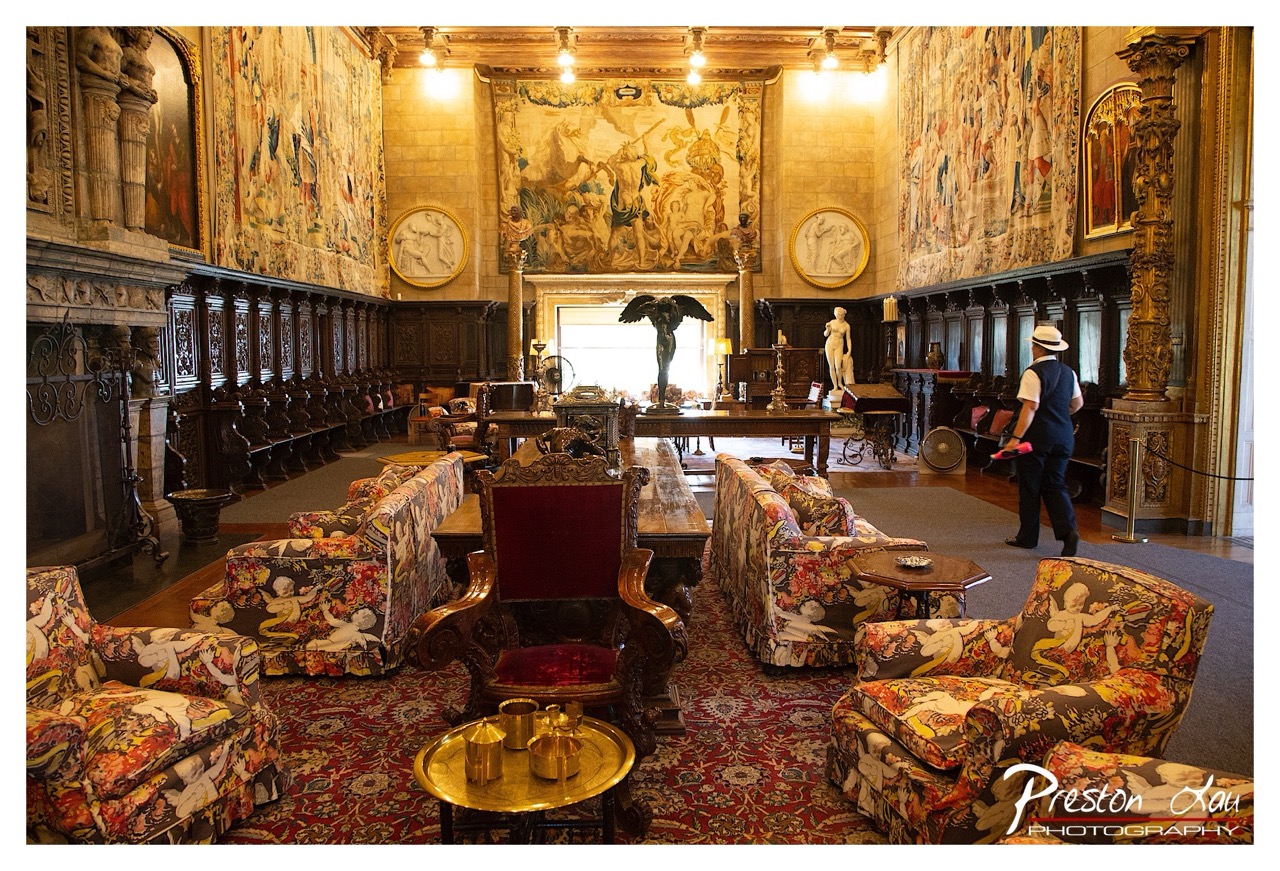

Overwhelming Opulence
Rating: 9/10
Welcome to the visual equivalent of "too much of a good thing," but in the most fabulous way possible. This grand interior subject scores a solid 9 for its sheer historical density and commitment to 'more is more'. We find ourselves in a room so lavishly decorated, it practically screams "I have a lot of stories and maybe a ghost or two." Dominating the scene are massive, intricate tapestries depicting scenes of classic mythology or perhaps just a very enthusiastic party. Flanking the room are dark, imposing wooden choir stalls that look like they've witnessed centuries of serious contemplation (or possibly just uncomfortable seating). In the foreground, an army of highly patterned sofas and chairs, featuring cherubs seemingly escaping a floral explosion, invite you to sit if you dare brave the sensory overload. The room is punctuated by sculptures, ornate tables, and a truly epic, winged bronze figure holding court in the center. Adding a touch of life (and perhaps a quest for the exit), a distinguished gentleman in a hat and vest ambles towards the back, giving a crucial sense of scale to this monumental space.
From a photographic perspective, this shot is a masterclass in trying to capture controlled chaos. The composition uses the heavily patterned furniture in the foreground to frame the view down the long hall, creating a sense of depth, although it does risk feeling a bit cluttered. The lighting is a mix, with bright natural light flooding in from the back, creating a dynamic range challenge, and warm artificial lights illuminating the ceiling, which adds to the opulent glow but also means dealing with mixed color temperatures. The deep depth of field ensures that almost everything is in focus, from the cherub-covered cushions up front to the gentleman in the distance, which is essential for showcasing the room's incredible detail. Capturing the textures of the tapestries, wood, and fabrics is a strong point here, bringing the historical setting to life. It’s the kind of place where every square inch demands attention, and the photographer has done well to present its overwhelming glory, even if navigating such a busy scene is like wrangling a flock of gilded swans.
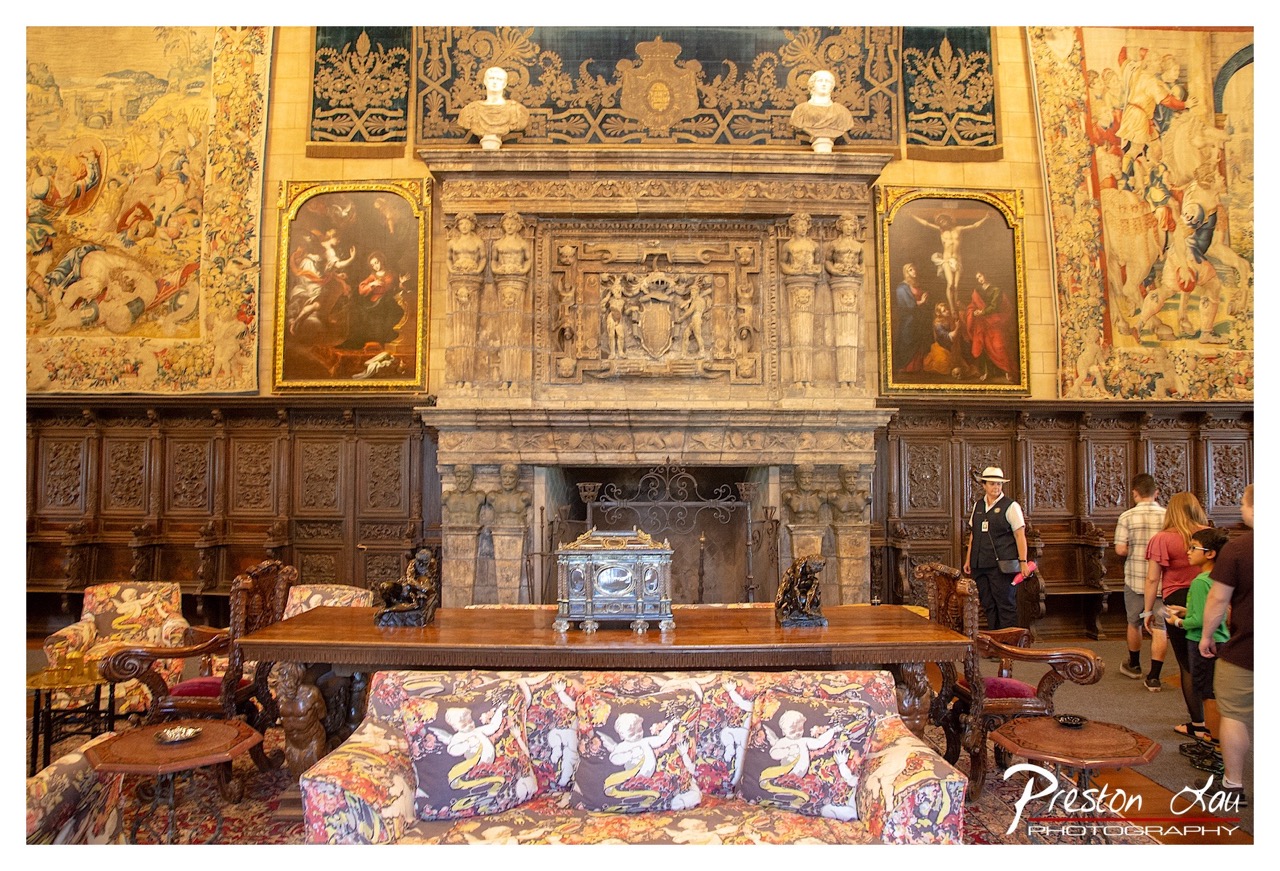

Grand Hall Grandeur (Cherubs Optional)
Rating: 8/10
Step right up into this lavish, overwhelming interior that screams "historical wealth!" The main subject here is clearly this magnificent, colossal stone fireplace, dwarfing the surrounding intricately carved wood paneling and rich tapestries that depict bustling, slightly chaotic scenes. What's happening? Well, tourists are doing what tourists do – observing, probably trying to figure out which era this is from (spoiler: it's old!), while a guide or staff member stands attentively, perhaps waiting for someone to ask if the cherub-upholstered furniture is original (doubtful, but points for bold fabric choices!). The mood is decidedly grand and opulent, perhaps bordering on excessive, but undeniably impressive. Compositionally, the shot captures the vastness of the space, though the foreground furniture does hog a bit of the stage, acting like a plush, patterned barrier between the viewer and the historical spectacle. Lighting seems to be a mix of overhead and ambient light, highlighting the textures of the stone and wood but leaving some corners a little mysterious.
From a photographic perspective, this is a classic interior documentation shot, trying to encapsulate scale and detail in challenging conditions. Shooting in low-ish light with such dynamic range between highlights (the fireplace) and shadows (the paneling) is tricky; the exposure seems decent, capturing detail in both. The wide-angle lens emphasizes the depth and height but introduces a touch of perspective distortion, especially noticeable at the edges. The color palette is dominated by warm browns, reds, and golds, befitting a historical setting, although the vibrant floral and cherub pattern on the furniture provides a jarringly modern pop. While the room itself is a feast for the eyes, the placement of the foreground furniture, particularly that dominant couch, feels a bit obstructive. It forces you to look *over* or *around* it to fully appreciate the grand fireplace and wall coverings. And let's not forget the ever-present watermark, reminding us who managed to capture this grand, cherub-filled tableau.
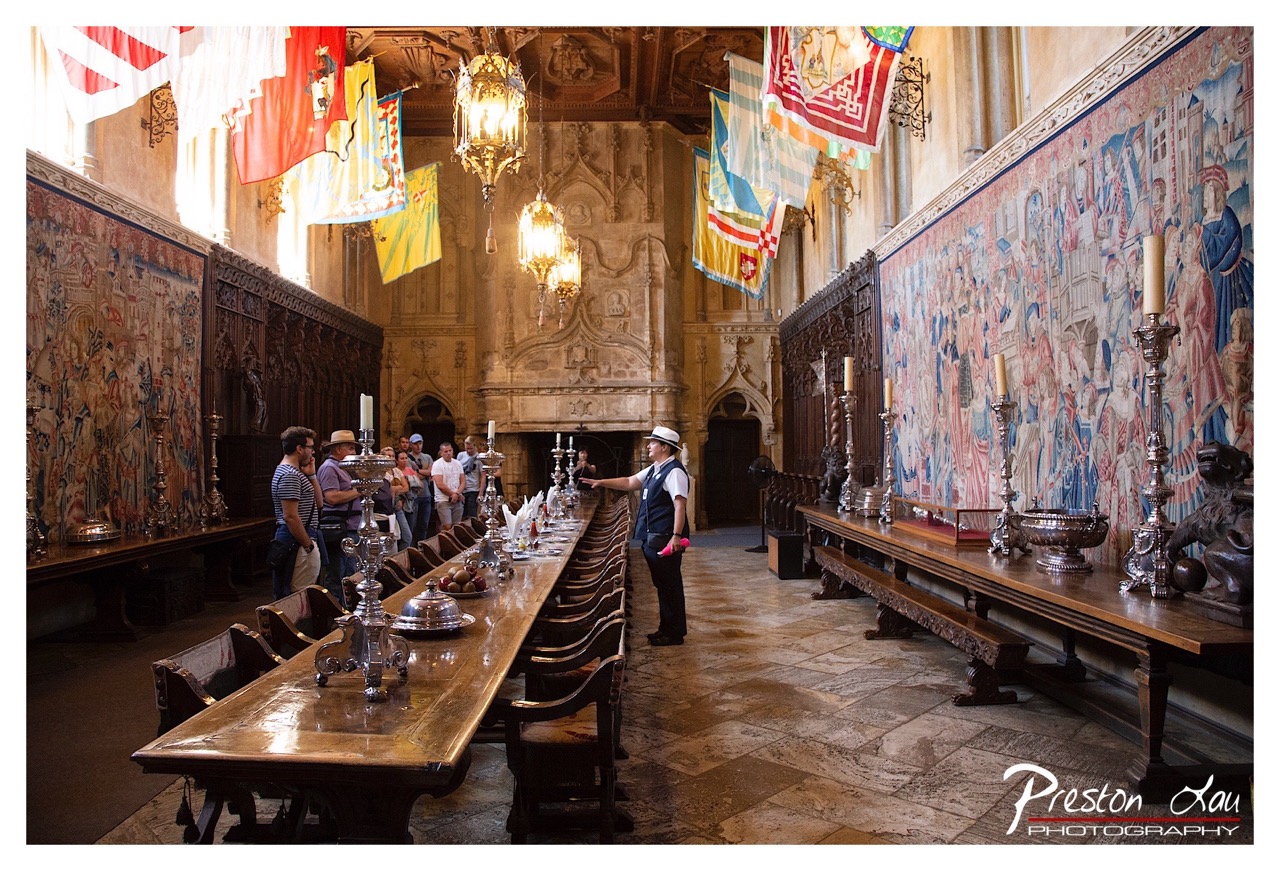

Royal Banquet Hall Tour
Subject Rating: 9/10 - The sheer grandeur and historical detail are immense, a feast for the eyes, even if slightly populated by modern folks in practical shoes.
Step right into a medieval postcard, albeit one where the postman brought along a dozen friends and a cheerful tour guide! This photograph captures the magnificent interior of what appears to be a grand hall, dominated by a seemingly endless, highly polished wooden table fit for a king (or at least a very large noble family). The walls are adorned with breathtaking, detailed tapestries depicting scenes lost to time, while colorful heraldic banners hang regally from the carved, elaborate ceiling. A group of tourists stands respectfully (mostly) along the table, eyes drawn to the guide, who gestures dramatically towards the far end, perhaps explaining the finer points of jousting while seated or the proper etiquette for throwing chicken bones onto the floor. The mood is one of awe and historical immersion, slightly leavened by the everyday reality of a guided tour – you can almost hear the faint murmurs and the occasional camera click.
From a photographic perspective, the composition leans heavily on the long table as a formidable leading line, drawing the viewer's eye into the depth of the hall towards the impressive fireplace structure in the background. The scale is effectively conveyed, though perhaps a wider lens might have captured even more of the soaring ceiling and wall details. Lighting is a mix of natural light streaming in from the upper windows, beautifully illuminating the banners and parts of the hall, and the warm glow of the decorative chandeliers, adding a touch of historical romance. The color palette is rich and varied, with the muted tones of the tapestries contrasting with the vibrant flags and the deep browns of the wood. It’s a classic example of capturing a grand historical interior, balancing the architectural subject with the human element of the visitors, making it feel lived-in and accessible rather than a sterile museum exhibit, although managing the dynamic range between bright flags and shadowed corners is always a fun challenge.
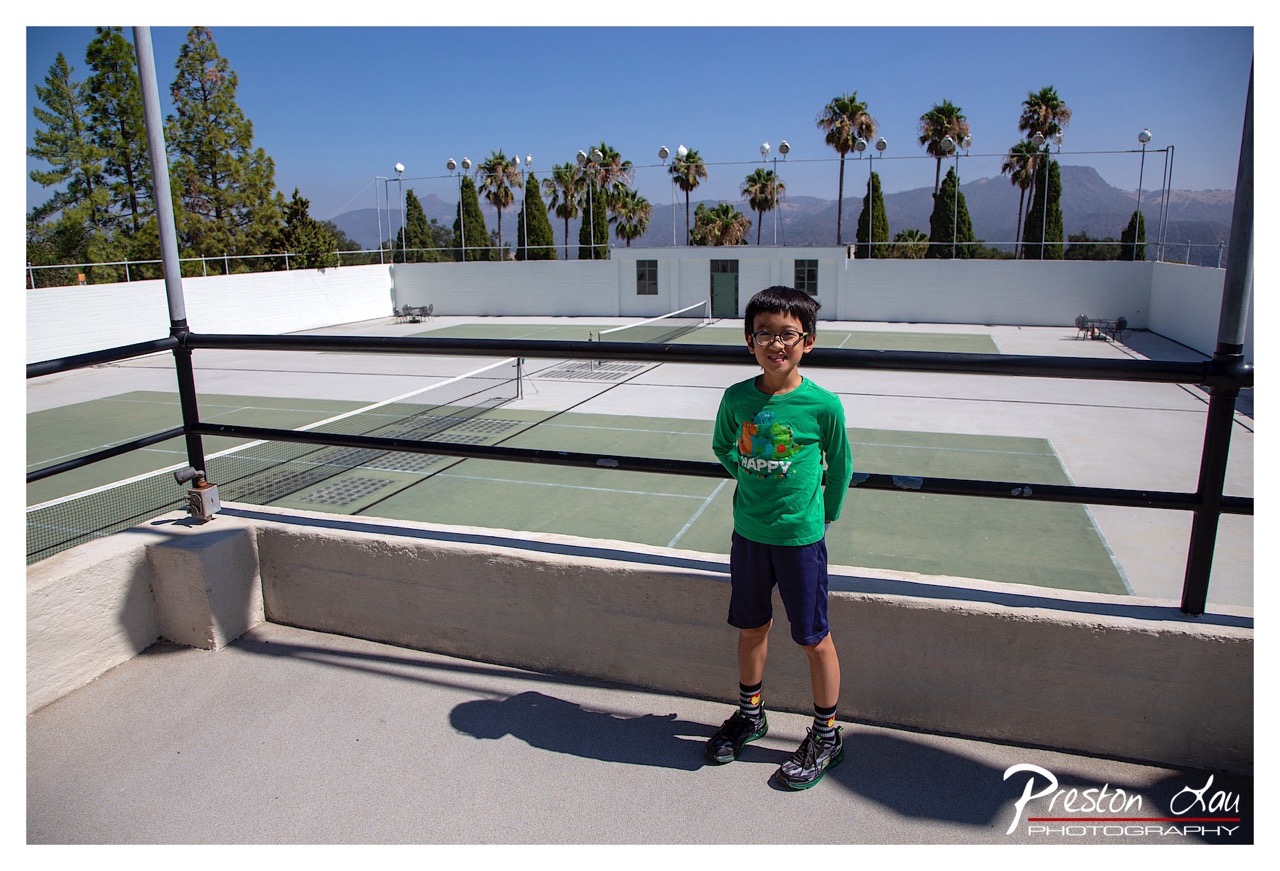

Courtside Charm
Subject Rating: 9/10
Gracing us courtside is this delightful young subject, radiating pure "HAPPY" vibes straight from his bright green long-sleeved tee adorned with what appears to be a trio of cheerful dinosaurs. Sporting glasses and a confident grin, he stands posed with hands behind his back, grounding the scene on a concrete platform overlooking a tennis court. The harsh, midday sun casts a dramatic, elongated shadow stretching before him, a testament to the clear conditions and perhaps a subtle nod to the photographer's willingness to embrace challenging lighting. The black railing in the mid-foreground provides a strong, albeit slightly obstructive, horizontal element, creating a visual layer that separates the viewer from the main action – or in this case, the potential action – on the courts below.
Beyond the immediate foreground, two tennis courts lie ready for play, their nets taut and surfaces marked. A clean, white building with green doors and windows serves as a backdrop, nestled against a larger white wall. The true stars of the background, however, are the majestic palm trees punctuated by evergreens, reaching towards a stunningly clear blue sky, with distant mountains adding a layer of serene grandeur. The composition uses the railing and concrete edge to frame the boy and the courts, though the railing does slice through the view rather assertively. The color palette is dominated by the vibrant greens and blues, feeling fresh and summery. Overall, it's a bright, cheerful environmental portrait, capturing a moment of simple happiness against a classic Southern California landscape, complete with the requisite photographer's watermark ensuring everyone knows who captured this sun-drenched moment.
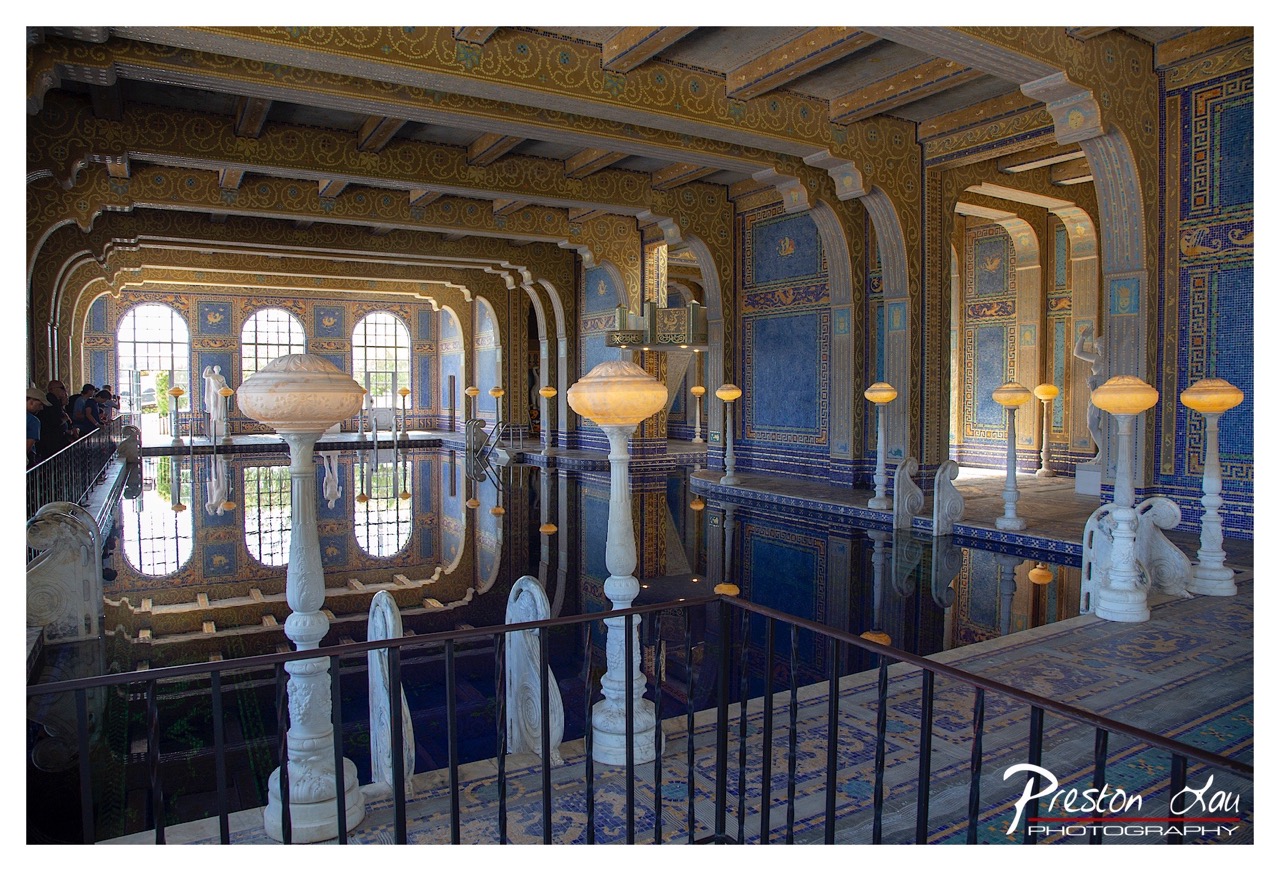

A Dip into Excess: The Roman Pool Spectacle
Subject Matter: 10/10
Welcome to the kind of swimming pool that makes your local leisure center look like a puddle – the Roman Pool at Hearst Castle, a subject that scores a perfect ten for sheer, unadulterated visual drama. The scene is an intoxicating blend of ancient Roman decadence and early 20th-century extravagance, featuring a gloriously dark, reflective pool surrounded by walls and ceilings dripping with vibrant blue and gold mosaic tiles depicting mythological scenes and geometric patterns. A small group of mortals stands on a balcony to the left, gazing down at the watery mirror, while ornate, glowing lamps stand sentinel around the perimeter like luminous guardians of leisure. The air feels heavy with history and opulence, creating a mood that's both breathtakingly grand and perhaps a little intimidating for anyone just hoping to do a few laps. It's proof that some people really, really liked their bathing experiences to be visually overwhelming.
From a photographer's perspective, capturing this scene is a balancing act worthy of a high-wire artist. The composition uses the dark pool as a central reflective stage, mirroring the elaborate architecture above and the stately lamps and statues around the edges. The dark foreground railing adds a layer of depth, framing the view but also slightly impeding it – a common challenge when shooting from public viewpoints, because apparently you can't just jump in for a closer look (seriously, what's the point of all that opulence if you can't dive?). The lighting is a mix of bright natural light streaming through the large arched windows on the left and the warm, artificial glow of the unique lamps, creating interesting highlights and reflections on the water's surface. The rich blue and gold color palette is the star here, making the mosaics pop and giving the image a regal, almost otherworldly feel. It’s a testament to capturing not just a place, but an era of magnificent, over-the-top luxury that probably required a wide-angle lens and prayers to the exposure gods to avoid blown-out windows and murky shadows simultaneously.
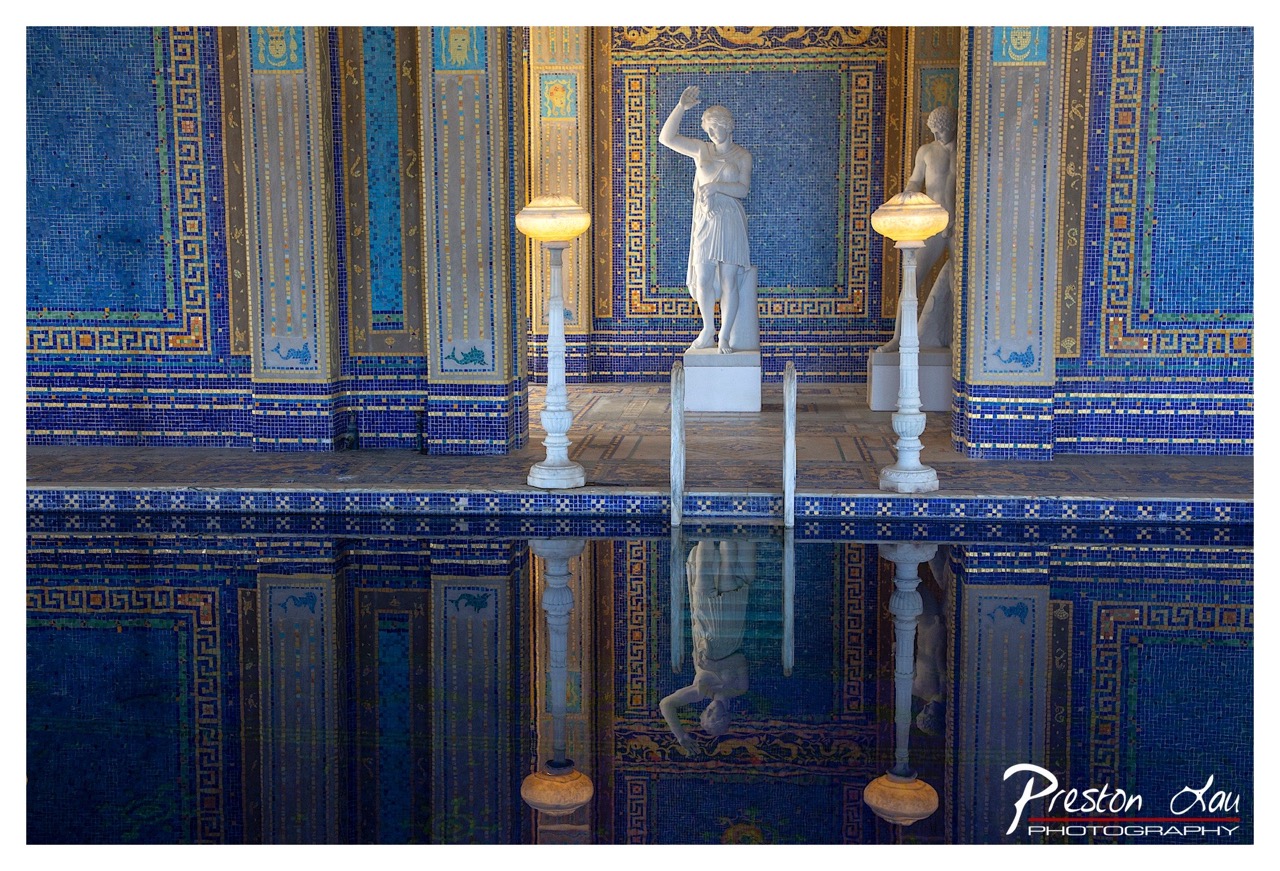

The Roman Pool at Hearst Castle - A Study in Aquatic Opulence
Rating: 9/10 (for sheer, unapologetic extravagance)
Ah, the Roman Pool at Hearst Castle, where W.R. Hearst clearly decided that if he was going to swim indoors, it might as well feel like a dive into a golden age, literally. This image perfectly captures the dizzying opulence of the space, a veritable explosion of blue and gold mosaic tiles that probably caused several ancient Romans to roll in their graves from envy. The scene is serenely still, allowing the mirror-like surface of the pool to double the visual assault of the walls, creating a reflection so sharp it looks like the room was flipped upside down. Two classical statues stand sentinel, looking perhaps slightly overwhelmed by the sheer volume of shiny tesserae surrounding them, while ornate lamps stand ready to cast a warm, if perhaps unnecessary, glow on the already dazzling scene. It's a mood that screams "I have more money than I know what to do with, so I built a pool that would make Midas blush."
From a photographic standpoint, the composition leans into the inherent symmetry and reflective qualities of the pool. Placing the pool edge relatively central emphasizes the stunning reflection, which is arguably the star of the show here. The lines of the pool edge and the architectural elements provide strong geometric structure against the busy patterns of the mosaics. Lighting appears balanced, showcasing the vibrant blues and golds without blowing out highlights, though the lamps add a nice touch of warmth. Capturing such a sharp reflection requires a stable camera and perhaps a bit of luck with still water, which the photographer clearly had. The detail in the mosaics is well-preserved, allowing the viewer to appreciate the intricate patterns and designs. It’s a solid shot that successfully conveys the jaw-dropping scale and design philosophy (or lack thereof, depending on your taste) of this unique historical interior.
Loading map...